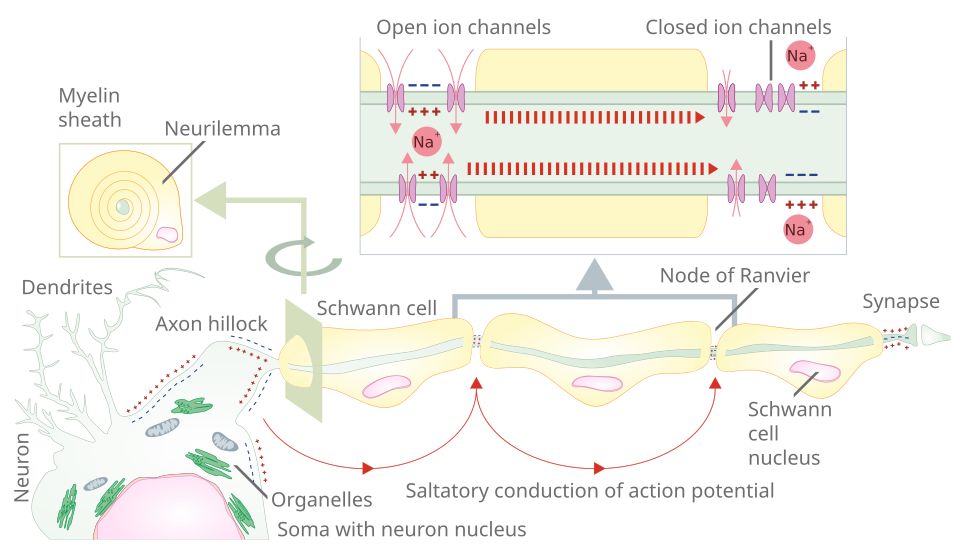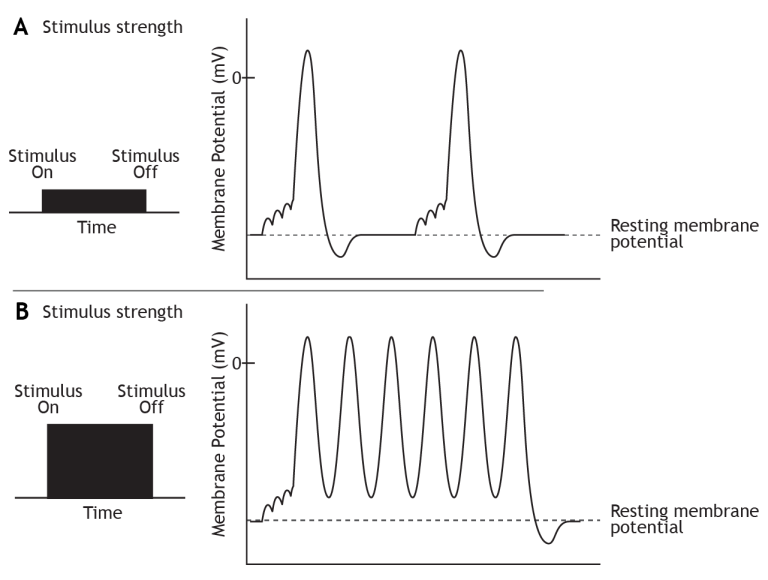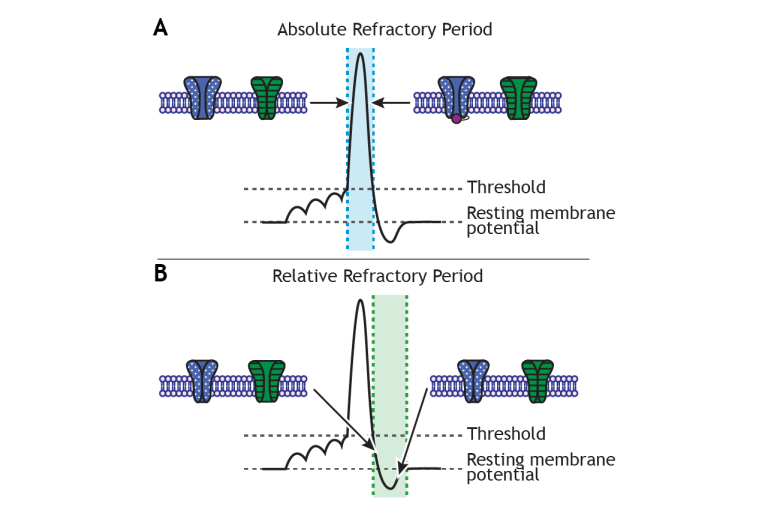OCR Specification focus:
‘Describe transmission of action potentials in myelinated neurones and the significance of impulse frequency in signalling stimulus intensity.’
Electrical impulses, or action potentials, transmit information rapidly along neurones. In myelinated neurones, transmission is faster and more efficient, while impulse frequency conveys the intensity of stimuli to the central nervous system.
Transmission of Action Potentials in Myelinated Neurones
Structure and Function of Myelinated Neurones
Myelinated neurones possess a myelin sheath, an insulating layer formed by Schwann cells wrapping around the axon. The sheath prevents ion movement across most of the axon membrane, except at nodes of Ranvier—small, unmyelinated gaps where ion channels are concentrated.
Myelin sheath: A fatty, insulating layer around an axon that increases the speed of electrical impulse transmission.
The myelin sheath’s insulating properties allow impulses to jump between nodes of Ranvier in a process called saltatory conduction, significantly increasing transmission speed compared to unmyelinated neurones, where depolarisation occurs continuously along the membrane.

Diagram of saltatory conduction along a myelinated axon showing Schwann cells, myelin sheath, and nodes of Ranvier with conduction arrows. Ion flow and depolarisation are restricted to the nodes, enabling rapid, energy-efficient transmission. Labels are minimal and focused on structures required by the OCR specification. Source.
Saltatory Conduction
In a myelinated neurone, depolarisation at one node triggers depolarisation at the next, without the entire axon membrane undergoing depolarisation. This ‘leaping’ mechanism results in rapid conduction and reduced energy expenditure.
Key advantages of saltatory conduction:
Increased speed: Transmission can exceed 100 m/s, compared to around 0.5–10 m/s in unmyelinated neurones.
Energy efficiency: Fewer Na⁺/K⁺ pumps are needed to restore resting potential, as fewer ions cross the membrane.
Signal integrity: The insulating myelin prevents cross-talk between adjacent neurones, maintaining distinct signals.
Saltatory conduction: The jumping of an action potential from one node of Ranvier to the next in a myelinated neurone.
Sequence of Impulse Transmission
Impulse transmission follows a consistent pattern of depolarisation, repolarisation, and recovery:
Resting potential: The neurone membrane is polarised at approximately –70 mV, maintained by sodium–potassium pumps actively transporting Na⁺ out and K⁺ in.
Depolarisation: When a stimulus exceeds the threshold potential, voltage-gated Na⁺ channels open, allowing Na⁺ influx, reversing membrane polarity.
Action potential: The inside becomes positive (+40 mV).
Repolarisation: Na⁺ channels close; voltage-gated K⁺ channels open, allowing K⁺ efflux, restoring negativity.
Hyperpolarisation and recovery: The membrane briefly becomes more negative than the resting potential before returning to the resting state via the Na⁺/K⁺ pump.
Action potential: A rapid, temporary change in membrane potential that transmits an electrical signal along a neurone.
This process ensures unidirectional transmission, as the refractory period—a short phase when Na⁺ channels are inactivated—prevents the impulse from travelling backward.
Factors Affecting Speed of Transmission
Several variables influence the rate of impulse transmission:
Myelination: Increases conduction speed due to saltatory conduction.
Axon diameter: Larger diameters reduce resistance to ion flow, enhancing speed.
Temperature: Higher temperatures increase kinetic energy, accelerating ion movement and pump activity, up to a biological limit.
These factors ensure that the nervous system can adapt transmission speed for efficient coordination and response.
Frequency Coding of Impulses
Stimulus Intensity and Action Potential Frequency
Unlike electrical currents, action potentials are all-or-nothing events. Their amplitude remains constant, regardless of stimulus strength. Instead, stimulus intensity is encoded by the frequency of action potentials—a process known as frequency coding.
All-or-nothing principle: Once threshold potential is reached, an action potential is generated; below this level, none occurs, regardless of stimulus strength.
The greater the stimulus, the higher the frequency of action potentials generated per second.

Two spike-train panels compare weak versus strong stimuli: weak stimuli elicit few, spaced action potentials; strong stimuli produce many, rapid spikes. The figure cleanly demonstrates all-or-nothing amplitude with information encoded by firing rate, aligning with OCR’s focus. Source.
The CNS interprets the rate of arrival of impulses as a measure of stimulus strength, e.g., stronger pressure or brighter light.
Frequency coding allows graded sensory perception, enabling organisms to adapt and respond appropriately to environmental changes.
Role of the Refractory Period in Frequency Limitation
Following each action potential, a refractory period occurs, divided into absolute and relative phases:
Absolute refractory period: No new action potential can be initiated because Na⁺ channels remain inactivated.
Relative refractory period: A stronger-than-normal stimulus may initiate a new impulse as Na⁺ channels reset.
Refractory period: The period after an action potential during which the neurone cannot or is less likely to generate another action potential.
The refractory period sets an upper limit on the maximum frequency of action potentials, ensuring discrete, non-overlapping impulses and allowing the neurone to recover.

Diagram contrasting absolute and relative refractory periods with channel-state cues, clarifying why spikes cannot occur (absolute) and why a stronger stimulus is required (relative). This figure ties refractory dynamics to maximum firing rate; Na⁺/K⁺ channel details extend slightly beyond the syllabus but aid comprehension. Source.
Physiological Significance of Frequency Coding
Frequency coding provides several essential functions in neuronal communication:
Stimulus intensity representation: The CNS interprets higher firing frequencies as stronger stimuli.
Prevention of signal saturation: Refractory periods prevent continuous depolarisation, maintaining clear temporal separation of signals.
Adaptive control: Variable frequency enables fine motor control and sensitivity adjustments in sensory systems.
Homeostatic regulation: Internal sensors, such as baroreceptors and chemoreceptors, use frequency changes to regulate processes like blood pressure and respiration.
Integration of Transmission and Frequency Coding
Impulse transmission and frequency coding operate together to ensure precise and adaptable communication:
Transmission provides the rapid, directional movement of impulses along neurones.
Frequency coding translates the strength of external or internal stimuli into a meaningful, interpretable signal.
Together, these mechanisms enable organisms to detect, interpret, and respond to their environments efficiently, maintaining coordination and homeostasis across complex biological systems.
FAQ
Saltatory conduction minimises the number of ion exchanges across the axon membrane. Because depolarisation only occurs at nodes of Ranvier, far fewer sodium–potassium pumps are required to restore resting potential.
This efficiency reduces ATP demand, as energy is not wasted repolarising sections of membrane insulated by the myelin sheath. Consequently, myelinated neurones transmit impulses both faster and more economically than non-myelinated ones.
Apart from myelination, conduction speed depends on:
Axon diameter: Wider axons reduce electrical resistance, allowing faster ion flow.
Temperature: Higher temperatures increase kinetic energy, accelerating ion diffusion and channel activity (up to a physiological limit).
Ion concentration: Adequate sodium and potassium levels are essential for efficient depolarisation and repolarisation.
These factors ensure that the nervous system maintains optimal signalling under varying environmental and physiological conditions.
The refractory period behind an action potential temporarily inactivates sodium channels, preventing immediate re-opening.
As a result, depolarisation can only trigger adjacent regions ahead of the impulse, enforcing a one-way flow from the axon hillock toward the axon terminals. This directional transmission ensures clear, coordinated signalling and prevents the confusion of backward-travelling impulses.
In conditions such as multiple sclerosis, immune-mediated damage to the myelin sheath disrupts saltatory conduction.
Consequences include:
Slower transmission: Loss of insulation forces impulses to move continuously instead of jumping between nodes.
Signal degradation: Leakage of ions causes incomplete depolarisation.
Loss of coordination: Irregular conduction can lead to muscle weakness or sensory disturbance.
This highlights the critical role of myelin in maintaining rapid, reliable communication in the nervous system.
The length of the refractory period—particularly the absolute refractory phase—determines the upper limit of firing frequency.
During this period, sodium channels remain inactivated and cannot reopen, no matter how strong the stimulus.
Once the membrane enters the relative refractory phase, a stronger stimulus may generate another action potential. The combination of these time intervals defines how rapidly a neurone can repeatedly fire, influencing how finely it can encode stimulus intensity.
Practice Questions
Question 1 (2 marks)
Explain why the transmission of an action potential is faster in a myelinated neurone than in a non-myelinated neurone.
Mark Scheme:
1 mark for stating that depolarisation only occurs at nodes of Ranvier.
1 mark for explaining that impulses jump between nodes (saltatory conduction), speeding transmission compared to continuous conduction along the whole axon.
Question 2 (5 marks)
Describe how the frequency of action potentials conveys information about the intensity of a stimulus and explain the role of the refractory period in this process.
Mark Scheme:
1 mark for stating that action potentials are all-or-nothing and their amplitude remains constant.
1 mark for explaining that stronger stimuli cause a higher frequency of action potentials.
1 mark for describing that the CNS interprets frequency as the measure of stimulus strength or intensity.
1 mark for identifying that the refractory period prevents immediate re-excitation, ensuring discrete impulses.
1 mark for explaining that the refractory period limits the maximum firing frequency, setting an upper limit on how stimulus intensity is coded.

